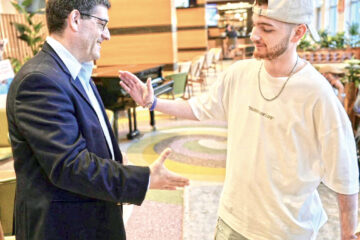Cookbooks make great Chanukah gifts
By Ethel G. Hofman, Special To The Dayton Jewish Observer
When the wind is howling and it’s cold and wet outside, I love to curl up in a cozy armchair and read about food in far-off places. Then it’s into the kitchen to cook up one of the tempting recipes featured in glorious color.
This year’s crop of cookbooks runs the gamut from Jewish bakery recipes and memories, recipes and stories from a Polish summer, and a practical, enticing gluten-free vegetarian collection. Most of the recipes may be prepared in a kosher kitchen.
Inside The Jewish Bakery: Recipes and memories from the Golden Age of Jewish Baking by Stanley Ginsberg and Norman Berg, Camino Books, 2011. Hardback: $24.95
If you only buy one cookbook this year, it must be Inside the Jewish Bakery. The authors, who both grew up in New York’s outer boroughs in the decades following World War II, have put together a riveting collection of memories and recipes.
They have scrupulously researched culinary culture from the early 16th century when Yiddish civilization began to reach its peak, to the food habits in shtetl living and into the present-day where frozen, ready-to-bake breads, cakes and cookies led to the demise of the Jewish bakery.
For me, the pages brought back delicious memories of the family owned Jewish bakeries I visited daily when I lived in Brookline, Mass. But in this bakery tome, recipes with the tastes and smells of a bygone era can be recreated by even the beginning home baker.
Each story is riveting, each recipe is written in easy to follow detail. The recipes consist of two elements; formulas and techniques. Recipes begin with a diagram showing each ingredient measured in volume, ounces and grams so this book may be used internationally. Illustrations give step-by-step instructions so you can’t make a mistake. The photography of dishes like the golden crusted challah, apple strudel studded with chunks of apple and raisins, and glossy nut crusted almond buns will inspire you to rush to gather ingredients and bake. It did for me with scrumptious results. No store-bought baked item can compare with the tastes and aromas of these recipes culled from Inside a Jewish Bakery. Read carefully and success will follow.
Edible Brooklyn: A close to home culinary celebration of Brooklyn’s diverse cultures, edited by Rachel Wharton, photos by Carol Topalian, Sterling Epicure, 2011. Hardback: $18.95
The recipes are unpretentious, culled from the kitchens and pantries of people like a farmstead cheese monger, rooftop gardeners, a musician who writes ditties for summer ice cream trucks and many others who make up today’s flourishing Brooklyn food community. Almost all the recipes may be prepared in a kosher kitchen. I couldn’t resist making Chocolate Covered Kale Chips, Pickled Herring, and Potato Salad with delicious results.
This is the first in a series of four Edible cookbooks all from the Edible Communities family of magazines published in distinct culinary regions of North America focusing on information about the local foods movement. Part travel guide, part recipe collection, Edible Brooklyn features photographs and profiles of real people in the food business and more than 100 recipes, tips and techniques.
Rose Petal Jam: Recipes and stories from a summer in Poland by Beata Zatorska and Simon Target. Tabula Books, 2011. Hardback: $35.
Through brilliant photography, Simon Target has captured the scenery and flavors of Poland’s towns and countryside. Beata Zatorska, returning to the village where she was raised in the 1960s and 70s, reminisces with nostalgia.
Zatorska now lives in Australia but the stories of her childhood come alive on every page. It was from her late grandmother that a deep love of her country and its complex cuisine was instilled in Beata.
Her grandmother, a professional cook, came from Lwow, one of the most ethnically diverse regions of Central Europe so that recipes like Matzah Ball Soup and Herring in Sour Cream reflect the influence of a past Jewish culture.
However, note that the ingredient amounts are in grams and ounces so that they need to be converted to cup measurements before cooking. (Ingredient equivalents may be found online).
All said, Rose Petal Jam is a beautiful coffee table book celebrating the sounds, sights and foods of Poland, and written with love.
125 Gluten Free Vegetarian Recipes by Carol Fenster, Ph.D., Avery Publishing, 2011. Soft cover: $18
Gluten free and vegetarian are two of the hottest food and health issues in America today. And Carol Fenster, an internationally-recognized expert in gluten free and vegetarian cooking, is well-equipped to author this “perfect storm of a cookbook.” Inspired by her personal experiences and the knowledge that 22 million Americans are sensitive to gluten, Fenster has created 125 recipes which are not only gluten free but vegetarian.
The list of contents is broken down into Main Dishes which is divided into Pasta Dishes, Stuffed Vegetables, Casseroles, Beans and Lentils and other wheat-free, vegetarian dishes. Under Vegetables, you’ll find Cold Salads, Hot or Fried Vegetables and Roasted Vegetables. The list goes on to a mouthwatering variety of Soups and Stews, Appetizers, Breads and Desserts. One of the most important sections is Basics: how to prepare ingredients such as gluten-free crumbs, broths, and Pesto and sweetened condensed milk that commonly contain dairy.
Store-bought, these items can wreak havoc with a budget. Make at home and you’ll save mucho dollars. The nutritional analysis per serving is included with each recipe.
With scores of tips and resources, this is an essential book for those on gluten-free, vegetarian diets. The recipes are so deliciously indulgent they can be served to everyone concerned with a health food lifestyle. Dishes such a Caponata appetizer or All-American Cherry Pie will get rave reviews from every guest, no matter their nutritional preferences.
Les Petits Macarons: Colorful French Confections to Make at Home by Kathryn Gordon and Anne E. McBride, Running Press, 2011. Hardback: $18
Macarons are the traditional French treats. You see them in French bakeries and in specialty food stores. These little meringue based, pastel colored cookies sandwiched with a creamy fruit-based or chocolate filling are expensive and often difficult to find. But no longer. Gordon and McBride have taken these melt-in-the mouth, crisp shells with soft fillings and turned them into simple, high-quality recipes for the home baker.
And not just sweet macarons. There are recipes for a variety of savory shells and dozens of fillings. They even give the option of four different meringue methods; French, Italian, Swiss and Kathryn’s Easiest French Macaron method.
There are only four ingredients for each method. Variations depend on how the sugar is added to the egg whites and whether or not the sugar is heated. The authors suggest trying each method and then deciding which one works best for your skills and equipment. Other than Kathryn’s Easiest French Macaron method, French meringue is the simplest since it needs minimal equipment and no manipulation of hot sugar. Besides clear instructions for each recipe, there is a history of macarons (the Italian term is of Greek origin), the anatomy of a macaron (skin and foot) and a description and importance of the four main ingredients.
Best of all, these tiny gems filled with ganache, butter cream or ice cream freeze very well for up to a month. Wrap in plastic wrap in groups of six and store in a container so they don’t get crushed. Then they’re ready to serve at a moment’s notice.
The Pink Princess Party Cookbook by Barbara Beery, Simon & Schuster, 2011. Hardback: $15.99.
My granddaughter Nicole has gone through the pink stages where it was essential that everything from clothes to lollipops had to be any shade of pink.
Now, at 11 years old, it’s onto purple but no little girl can resist being a Pink Princess. The Pink Princess Party Cookbook is Barbara Beery’s latest in the Pink Princess cookbook series.
In hardback pink of course, it offers do-it-at home instructions for six whimsical princess-themed parties, all photographed in glorious pinks. In pages of Parent’s Notes, you’ll find safety and age-appropriate tasks as well as half a dozen tips, tricks and prep ideas.
Suit up with aprons and washed hands and guide them into your Enchanted Kitchen, a place where they can help create the party foods of their choice. For winter, there’s the Snowflake Princess Party where you’ll find directions for a frosty punch served in a sugar sipper cup or make a Crystal Candy Necklace, not just for winter.
A Spa Princess Party features Enchanted Sushi Roll-Ups and a recipe for a sweet-scented body lotion.
Parents and their princesses will have fun planning a party using themes in the book along with mix-and-match recipes. Whether for just three or four friends or a dozen classmates, they’ll go home with lots of spectacular memories and plans for their own princess parties.






